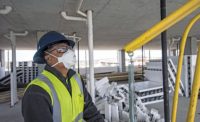Construction is a dangerous industry, and no segment is exempt. For contractors, projects come with inherent risks that can be minimized through proper precautions, practical training and ongoing education. A few of the more well-known dangers include fall hazards, electrical fires and accidents involving tools and equipment.
Dust poses significant health risks, as well.
Because the threat is not immediately obvious, dealing with dust is a task that some contractors don’t take as seriously as other potential issues. Others understand that breathing in the particles and byproducts created during a project may be harmful, but they aren’t sure how to eliminate it. Still others are more concerned with protecting the building interior and client belongings rather than their own health and that of everyone that comes into contact with the job site.
For decades, contractors tried to control dust with basic—and largely ineffective—methods. While covering and cleaning does protect flooring, furniture and other items, it doesn’t remove dust from the building or improve indoor air quality.
During a typical remodeling or renovation project, numerous dust generating events like demolition and drywall sanding will occur. Dust is everywhere when replacing or refinishing walls or ceilings. Common harmful substances that may be uncovered during the renovation of an older building include:
- Dirt and debris
- Organic matter like rodent feces and dead bugs
- Materials like drywall, cement and sawdust
- Substances such as silica, asbestos and lead
- Mold and mildew
- Volatile organic compounds
What’s the Danger?
Invisible doesn’t mean harmless. Smaller dust particles—including ones you can’t see—are the most hazardous. They are lighter, stay in the air longer and travel farther than larger particles. According to the U.S. Environmental Protection Agency, “The size of particles is directly linked to their potential for causing health problems. Small particles less than 10 micrometers in diameter pose the greatest problems, because they can get deep into your lungs, and some may even get into your bloodstream. Exposure to such particles can affect both your lungs and your heart.”
The smaller the particle, the longer it lingers. According to the ISO, dust particles usually range in size from about 1 to 100 microns (µm) in diameter, “and they settle slowly under the influence of gravity.” Particles of a size of 15 to 100 microns (µm) can settle within one minute. Particles that are a size of 5µm will take eight minutes to settle. As particle size decreases, settling time increases. Particles smaller than 1µm may not settle at all but stay airborne permanently. Because these smaller particles are the most dangerous, it is critical to clean the air during a project in order to keep workers and occupants from being exposed to them.
We’re still learning just how dangerous some particles are. Silica can be found in ceiling tiles, plasters, fiberglass, mineral wool insulation and many other building products. When extremely small silica particles are inhaled deep into the lungs, silicosis and scarring of lung tissue can occur. It’s important to minimize exposure to this substance because the amount and duration of exposure are related to the probability of developing lung disease. The U.S. Department of Labor’s Occupational Safety and Health Administration reduced the permissible exposure limit to silica by 80 percent earlier this year, further demonstrating its danger and the need for precaution.
Breathing sensitivities and allergies can be aggravated. According to the CDC, more than six million children and 17 million adults in America suffer from asthma, and the number is growing. Millions more are living with COPD and other breathing issues, and children and the elderly are most vulnerable. Renovation and new construction projects can quickly exasperate breathing issues or even trigger an asthma attack if dust, chemicals and fumes are unmanaged.
Minimize the Dust Menace
As a contractor, it is your job to keep your clients and anyone who will come in contact with the worksite safe. Follow dust control best practices that include isolating the work area, sealing vents and air ducts and establishing negative air pressure while maintaining proper ventilation. If possible, cut wood, drywall, plastic, metal and other materials outside.
Additionally, use an air scrubber like the BuildClean Dust Control System to collect dust at the point of generation while it is still airborne. Collecting particulate in this manner is the most effective way to capture and eliminate all types of worksite dust before it can settle or migrate.
Not only is this the right thing to do, it’s also the right thing to do for your business.
Showing potential clients that you truly care about their safety and comfort during a project by eliminating one of their largest pain points is one way to build your reputation as a trustworthy professional.









